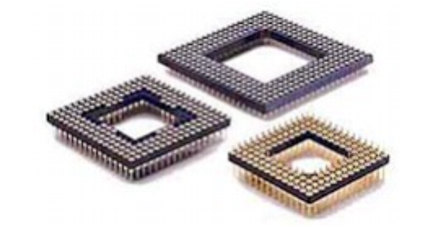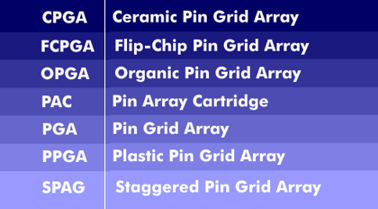pin grid array (chip design) (PGA)
The PGA package(Pin Grid Array), like the Ball Grid Array( BGA), is based on a specific grid for the connection pins. The PGA package and its variants CPGA (Ceramic), SPGA (Staggered), FC-PGA (Flip Chip) and PPGA (Plastic) have a square structure, are plugged into the PGA sockets and mechanically locked.
The PGA adapter is primarily used as a CPU socket and varies in the number of connections as well as the array arrangement. The pin rows can be arranged in parallel or offset. As with the BGA socket, the PGA socket also uses several outer pin rows for the connection contacts. The pin rows are marked with numbers and letters, starting with the notch.
The pin arrays can consist of two, three four or five rows and have up to 37 terminal pins in one row. Due to the large number of PGA variants, the different sockets are identified by numbers, from socket 1 to socket 8, as well as other socket types identified by letters and multi- digit numbers.
CPU sockets for PGA packages are used for 32- and 64-bit microprocessors with frequencies above 200 MHz. If they are made of ceramic, they are referred to as CPGA; if they are made of plastic, they are referred to as PPGA. The plastic packages are less expensive and superior to the ceramic packages in their thermal properties.
PGA packages are available for several hundred pins, up to more than 940, and come in a wide variety of types for central processing units (CPUs) used with high, low or low pressure. Others that are suitable for high temperatures, infrared light and swell baths, or are flame retardant.


